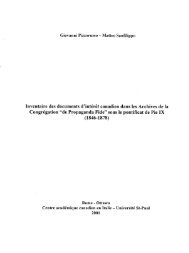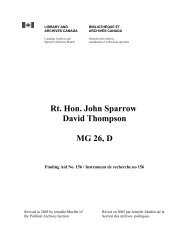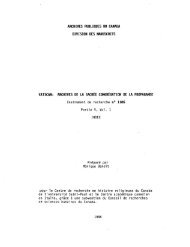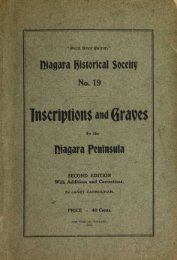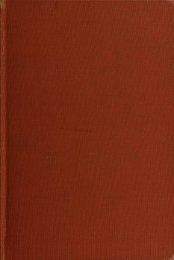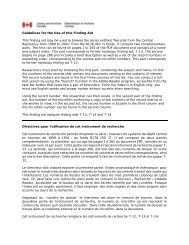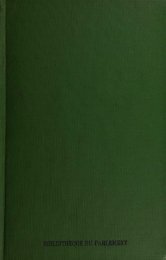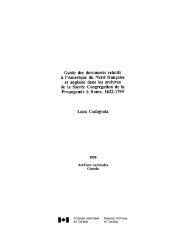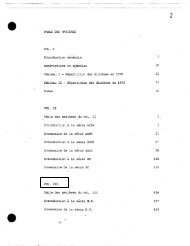Guide to Documents Relating to French and British North America in ...
Guide to Documents Relating to French and British North America in ...
Guide to Documents Relating to French and British North America in ...
Create successful ePaper yourself
Turn your PDF publications into a flip-book with our unique Google optimized e-Paper software.
Congregation, both the orig<strong>in</strong>al documents <strong>and</strong> the proceed<strong>in</strong>gs were recorded <strong>in</strong> Congregazioni<br />
Particolari. If discussed <strong>in</strong> a Congresso, no proceed<strong>in</strong>gs were recorded, but <strong>in</strong> every case a reply was<br />
prepared, <strong>and</strong> the copy of this reply filed <strong>in</strong> Lettere.<br />
Due <strong>to</strong> the above procedure, Lettere may be said <strong>to</strong> provide a key <strong>to</strong> the underst<strong>and</strong><strong>in</strong>g of<br />
Propag<strong>and</strong>a <strong>and</strong> its archives even better than Acta, <strong>in</strong> that Acta reflects only the documentary material<br />
of SOCG, while Lettere reflects SOCG <strong>and</strong> all other series.<br />
Most letters were written by Propag<strong>and</strong>a officials under the stimulus of <strong>in</strong>com<strong>in</strong>g documents that<br />
raised questions or simply new <strong>in</strong>terests. In this <strong>in</strong>stance, cross-references with other series (Acta,<br />
SOCG, Congressi, Udienze, etc.) are likely <strong>to</strong> exist. In some cases Propag<strong>and</strong>a officials <strong>to</strong>ok the<br />
<strong>in</strong>itiative, <strong>and</strong> wrote letters that apparently did not spr<strong>in</strong>g from matters already under discussion. In this<br />
second <strong>in</strong>stance, obviously, no cross-references with other series exist.<br />
Most volumes of Lettere conta<strong>in</strong> an <strong>in</strong>dex or summary of contents at the end of the volume<br />
itself. Some (vols. 32-39, 41-42, 44-52, 253, 257, 273-278), however, do not. There is also a good<br />
<strong>in</strong>dex <strong>to</strong> the letters written between 1750 <strong>and</strong> 1755. 10<br />
12. CONGRESSI<br />
The Congressi series conta<strong>in</strong>s the orig<strong>in</strong>al documents received by Propag<strong>and</strong>a <strong>and</strong> dealt with <strong>in</strong><br />
a Congresso. Congressi preserves letters, memor<strong>and</strong>a, petitions, short notes <strong>and</strong> documents meant for<br />
the Congregation's <strong>in</strong>ternal use. They came from <strong>in</strong>dividuals, <strong>in</strong>stitutions, missionaries, vicars apos<strong>to</strong>lic,<br />
bishops, nuncios, card<strong>in</strong>als, pontifical agents around the world <strong>and</strong> secret agents active <strong>in</strong> foreign l<strong>and</strong>s.<br />
As such, they do not differ substantially from the documents <strong>in</strong> SOCG. The reason why an <strong>in</strong>com<strong>in</strong>g<br />
document was filed under SOCG (<strong>and</strong> discussed <strong>in</strong> a General Congregation) or under Congressi (<strong>and</strong><br />
discussed <strong>in</strong> a Congresso) depended solely on the importance that the receiver (usually the secretary<br />
or the prefect) attached <strong>to</strong> it. Obviously, documents considered trivial at the time may now be of great<br />
his<strong>to</strong>rical significance.<br />
Apparently, Congressi was not <strong>in</strong>itiated at the beg<strong>in</strong>n<strong>in</strong>gs of Propag<strong>and</strong>a. Although some subseries<br />
have 1622 as their start<strong>in</strong>g year, most of them seem <strong>to</strong> start <strong>in</strong> the middle of the seventeenth<br />
century. While the prefect <strong>and</strong> the secretary met <strong>in</strong> Congresso before that time, the series is likely <strong>to</strong><br />
have been officialized only around 1668, when SOCG was reformed <strong>and</strong> organized chronologically<br />
rather than geographically.<br />
All the documents are bound <strong>in</strong> 1,451volumes, 129 of which were consulted for the purpose of<br />
the Calendar. Congressi is divided <strong>in</strong><strong>to</strong> two parts <strong>and</strong> many sub-series. The subdivision <strong>in</strong><strong>to</strong> two parts<br />
has little practical significance. In general, sub-series of the first part deal with mission terri<strong>to</strong>ries, while<br />
sub-series of the second part deal with the adm<strong>in</strong>istration of Propag<strong>and</strong>a or with its <strong>in</strong>stitutes (colleges,<br />
exam<strong>in</strong>ations of missionaries, staff, f<strong>in</strong>ances, etc.). This arrangement is rather irregular <strong>and</strong> cannot be<br />
wholly trusted.<br />
Much more important is the division <strong>in</strong><strong>to</strong> sub-series, accord<strong>in</strong>g <strong>to</strong> the country of orig<strong>in</strong> of the<br />
documents or <strong>to</strong> the subject treated. With<strong>in</strong> each sub-series, volumes are filed accord<strong>in</strong>g <strong>to</strong> a numerical<br />
<strong>and</strong> roughly chronological sequence. Many sub-series are followed by a number of miscellaneous<br />
volumes, which conta<strong>in</strong> documents relat<strong>in</strong>g <strong>to</strong> the same geographical area or <strong>to</strong> the same matter treated<br />
<strong>in</strong> the sub-series, but are usually undated. The volumes of Congressi have no <strong>in</strong>dices or tables of<br />
contents.<br />
37




